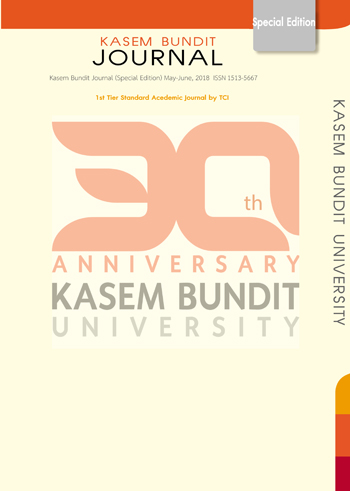Antecedents and Consequences of Emotional Dissonance among Call Center Agents
คำสำคัญ:
Emotional Dissonance; Strategic Deception, Customer Unfriendlines, Job satisfaction, Turnover Intentบทคัดย่อ
Emotional dissonance is a strong feeling of uneasiness commonly experience by call center agents when dealing with unfriendly customers. It is known to be detrimental to the workers’ emotional wellbeing, which, in turn, lead to the formation of attitudes and behaviors inimical to the employing center’s success. Aimed at identifying the determinants and the consequences of emotional dissonance, a structural equation modeling (SEM) analysis was performed using the data gathered from 689 randomly selected respondents working in eight call centers in the Philippines. The findings revealed that customer unfriendliness and strategic deception contribute to emotional dissonance, which, in turn, predicts job satisfaction negatively and turnover intent positively. From the valuable insights gained from the findings, the paper suggests that to limit the negative consequences of emotional dissonance (e.g., lower job satisfaction and greater turnover intent), the employment of strategic deception in the workplace has to be discouraged or, in some cases, its requirement has to be ceased. In addition, professional trainings or interventions aimed at helping agents develop coping strategies in dealing with unfriendly customers are also recommended to limit the impact of unfriendly customer behaviors on emotional dissonance.
เอกสารอ้างอิง
[2] Ashforth, B.E, & Humphrey, R.H. (1993). Emotional labor in service roles: The influence of identity. Academy of management review, 18(1), 88-115.
[3] Gosserand, R.H., & Diefendorff, J.M. (2005). Emotional display rules and emotional labor: the moderating role of commitment. Journal of Applied Psychology, 90(6), 1256.
[4] Wegge, Jürgen, Van Dick, Rolf, & Von Bernstorff, Christiane. (2010). Emotional dissonance in call centre work. Journal of Managerial Psychology, 25(6), 596-619.
[5] Dormann, C., & Zapf, D. (2004). Customer-related social stressors and burnout. Journal of occupational health psychology, 9(1), 61.
[6] Demerouti, E., Bakker, A.B., Nachreiner, F., & Schaufeli, W.B. (2001). The job demands-resources model of burnout. Journal of Applied psychology, 86(3), 499
[7] Lewig, K.A., & Dollard, M.F. (2003). Emotional dissonance, emotional exhaustion and job satisfaction in call centre workers. European Journal of Work and Organizational Psychology, 12(4), 366-392.
[8] Abraham, R. (1998). Emotional dissonance in organizations: Antecedents, consequences, and moderators. Genetic, social, and general psychology monographs, 124(2), 229.
[9] Chanco, B. (2017, March 31). Call Centers. Retrieved from https://www.pressreader.com/philippines/the-philippine-star/20170331/282003262264465
[10] Hechanova. (2013). The call center as a revolving door: a Philippine perspective. Personnel Review, 42(3), 349-365.
[11] Montecillo, P. (2012, March 31). Wellness wake-up call for ‘sleepless’ BPO agents. Retrieved from http://newsinfo.inquirer.net/169865/wellness-wake-up-call-for-sleepless-bpo-agents
[12] Melgar, I.E, Ofreneo, M.A.P, Kintanar, N.S., & Cand, M.A. (2009). Risk Behaviors for HIV/AIDS among Call Center Employees in the Philippines.
[13] Abraham, R. (1998). Emotional dissonance in organizations: antecedents, consequences, and moderators. Genetic, Social, and General Psychology Monograph, 2(124 ), 229-246.
[14] Dormann, C., & Zapf, D. (2004). Customer-related social stressors and burnout. Journal of occupational health psychology, 9(1), 61.
[15] Lewig, K.A., & Dollard, M. F. (2003). Emotional dissonance, emotional exhaustion and job satisfaction in call centre workers. European Journal of Work and Organizational Psychology, 12(4), 366-392.
[16] Demerouti, E., Bakker, A.B, Nachreiner, F., & Schaufeli, W.B. (2001). The job demands-resources model of burnout. Journal of Applied psychology, 86(3), 499.
[17] Walsh, G. (2011). Unfriendly customers as a social stressor–An indirect antecedent of service employees’ quitting intention. European Management Journal, 29(1), 67-78.
[18] Milawati, R.S. (2011). Light at Night: How the Offshore Call Center Industry Is Shaping Young Filipino Workers1. The Work of the 2010/2011 API Fellow, 192-201.
[19] Patwardhan, A., Noble, S.M, & Nishihara, C.M. (2009). The use of strategic deception in relationships. Journal of Services Marketing, 23(5), 318-325.
[20] Tett, R.P, & Meyer, J.P. (1993). Job satisfaction, organizational commitment, turnover intention, and turnover: path analyses based on meta‐analytic findings. Personnel psychology, 46(2), 259-293.
[21] Griffeth, R.W, Hom, P.W, & Gaertner, S. (2000). A meta-analysis of antecedents and correlates of employee turnover: Update, moderator tests, and research implications for the next millennium. Journal of management, 26(3), 463-488.
[22] Babbie, E. (2001). The practice of social research. Belmont, CA: Wadsworth/Thomson Learning: Inc.
[23] Nunnally, J.C. (1967). Psychometric theory (No. 152.8 N8).
[24] Zapf, D, Mertini, H, Seifert, C, Vogt, C, Isic, A, & Fischbach, A. (2005). Frankfurt emotion work scales—FEWS (Version 4.2.). Goethe Universität Frankfurt am Main.
[25] Brayfield, A.H., & Rothe, H.F. (1951). An index of job satisfaction. Journal of applied psychology, 35(5), 307.
[26] Wayne, S.J., Shore, L.M. & Liden, R.C. (1997). "Perceived organizational support and leader-member exchange: A social exchange perspective." Academy of Management journal 40, no. 1, 82-111.
[27] Hair, J.F., Black, W.C., Babin, B.J., Anderson, R.E., & Tatham, R.L. (1998). Multivariate data analysis . Uppersaddle River. Multivariate Data Analysis (5th ed) Upper Saddle River.
[28] Kenny, D. A., Kaniskan, B., & McCoach, D. B. (2015). The performance of RMSEA in models with small degrees of freedom. Sociological Methods & Research, 44(3), 486-507.
[29] Brown, S.P., & Peterson, R.A. (1993). Antecedents and consequences of salesperson job satisfaction: Meta-analysis and assessment of causal effects. Journal of marketing research, 30(1), 63.
ดาวน์โหลด
เผยแพร่แล้ว
รูปแบบการอ้างอิง
ฉบับ
ประเภทบทความ
สัญญาอนุญาต
ทัศนคติ ความคิดเห็นใด ๆ ที่ปรากฏในวารสารเกษมบัณฑิตฉบับนี้เป็นของผู้เขียน โดยเฉพาะ มหาวิทยาลัยเกษมบัณฑิตและบรรณาธิการ ไม่จำเป็นต้องมีความเห็นพ้องด้วย







